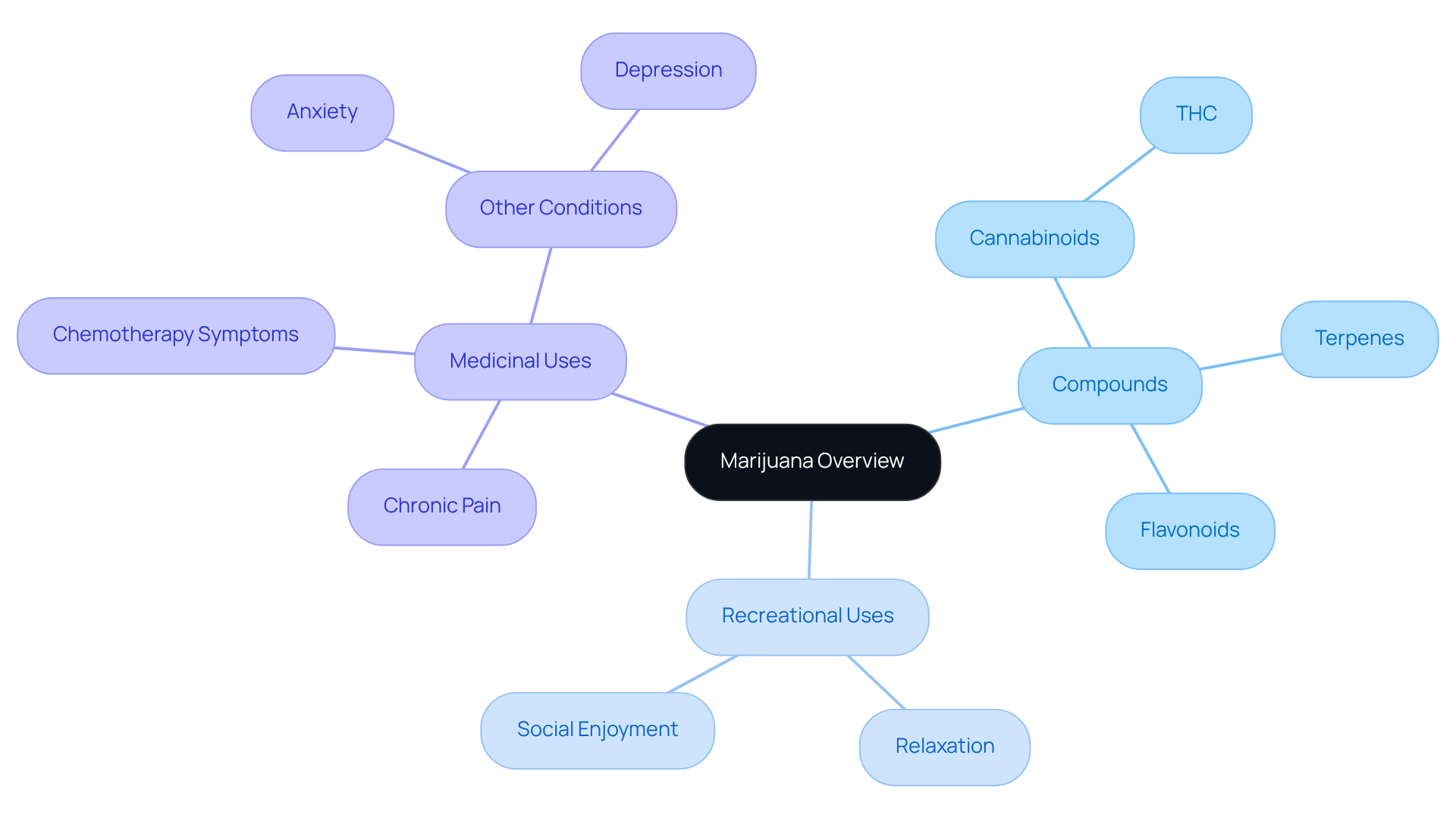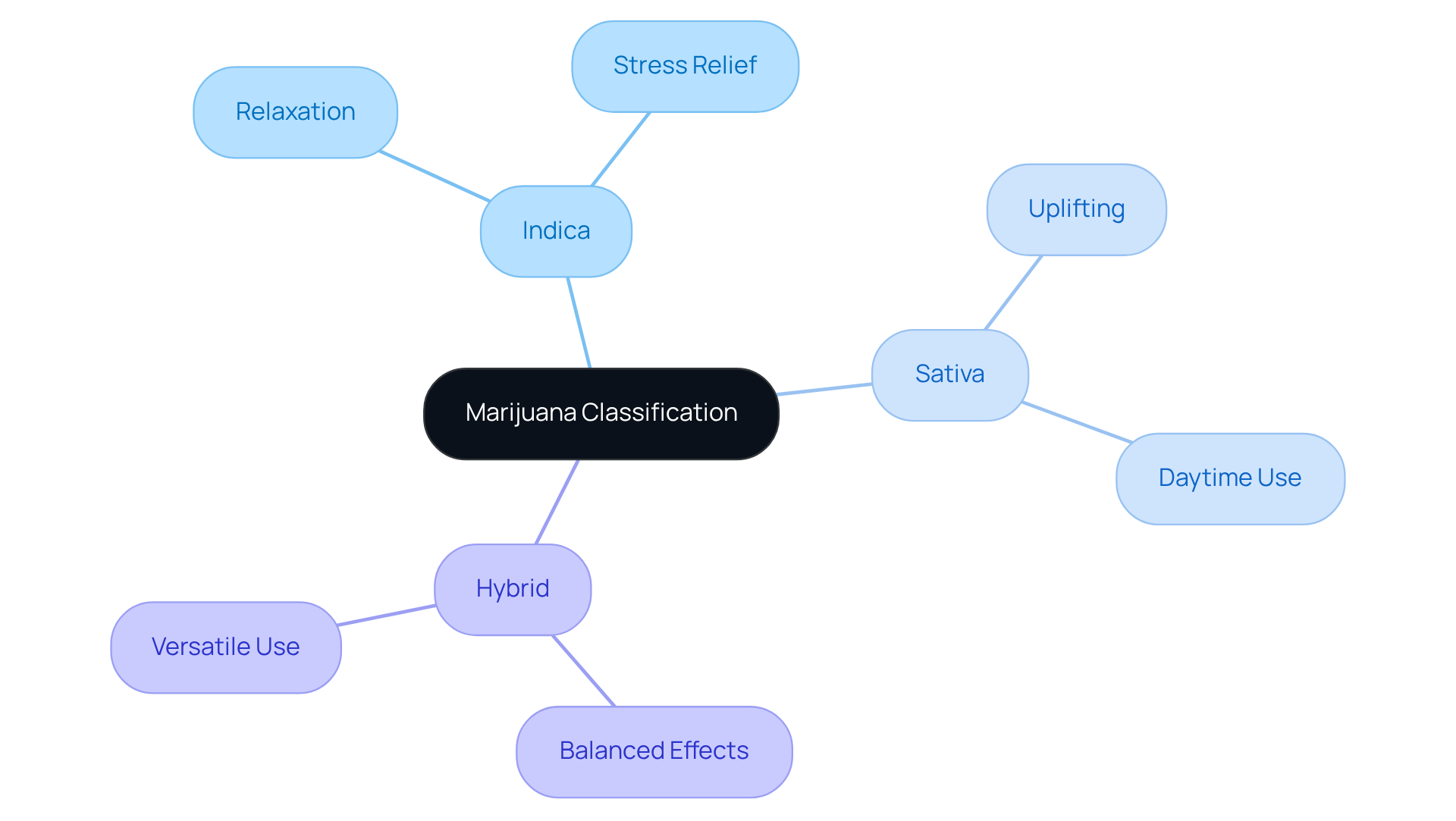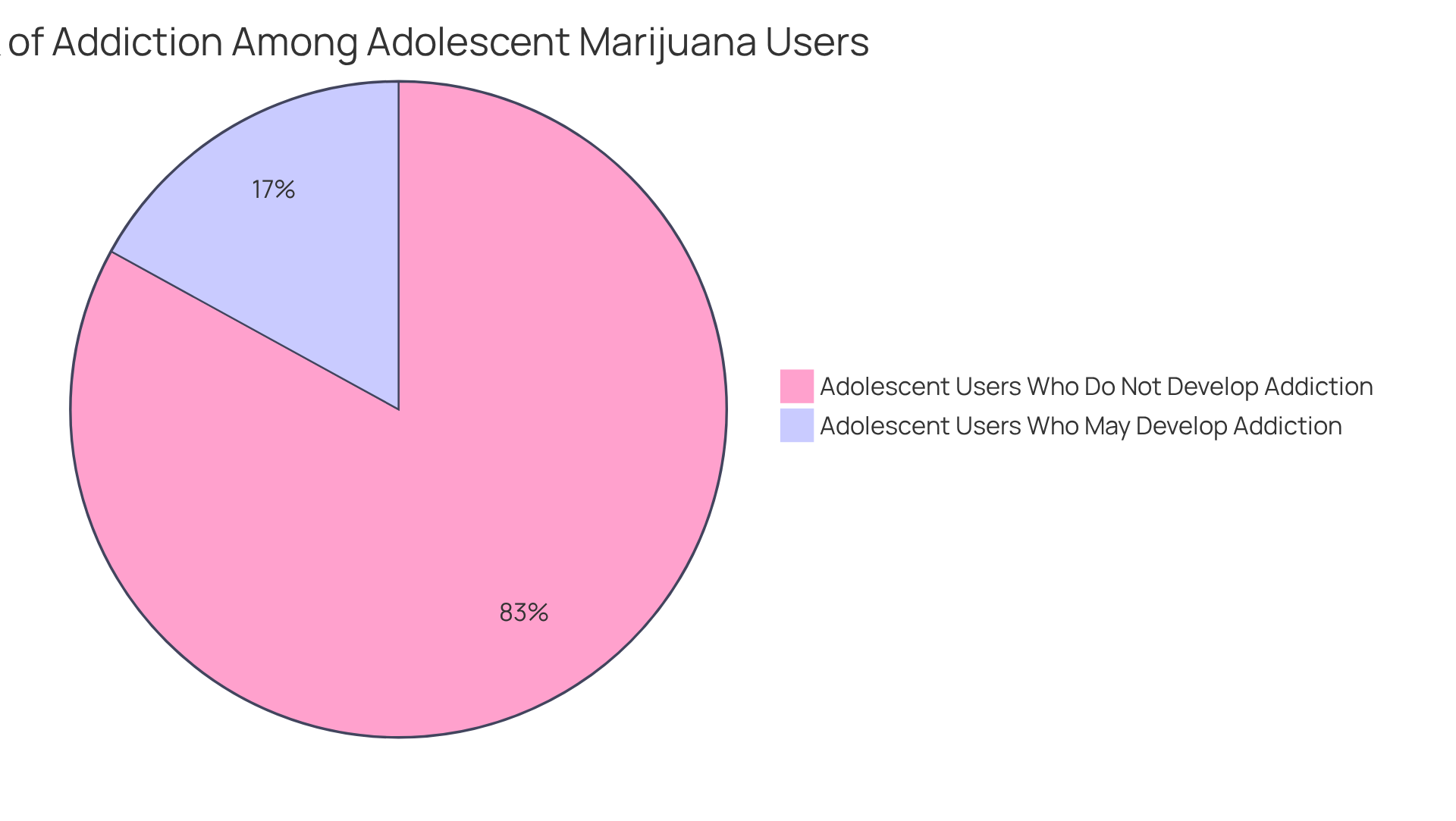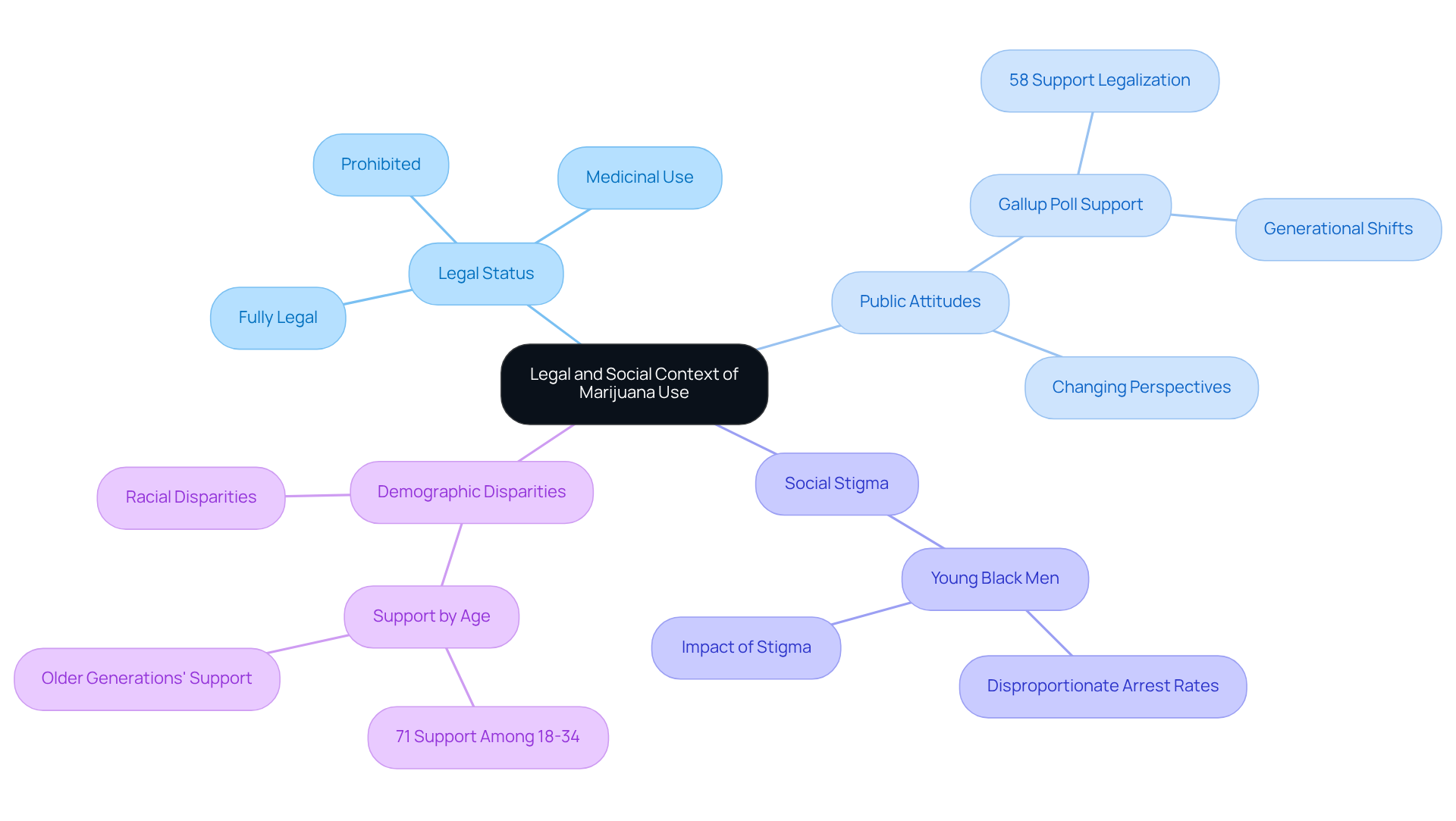Overview
Marijuana is often seen as a depressant because it can slow down the central nervous system, promoting relaxation and reducing anxiety. However, it’s important to recognize that it can also have stimulant and hallucinogenic effects, which can vary based on the strain and dosage. For instance, different strains like Indica and Sativa can influence mood and energy levels in unique ways. This complexity makes it challenging to categorize marijuana solely as a depressant.
Have you ever noticed how different strains affect your feelings and energy? Understanding these differences can empower you to make more informed choices. By exploring the various strains, you can find what works best for you, enhancing your experience and well-being. Together, let’s delve into this fascinating topic and discover how marijuana can fit into your life in a positive way.
Introduction
The classification of marijuana often sparks thoughtful discussion, especially when considering its role as a depressant. With its intricate composition of over 483 compounds, including the well-known THC, cannabis can evoke a variety of effects—such as relaxation, euphoria, and even heightened sensory awareness. Yet, we might wonder: is weed truly a depressant, or does it also have stimulant properties that can uplift mood and energy? This exploration invites us to delve into the multifaceted nature of marijuana, its diverse strains, and the implications for mental health and societal perceptions. Together, let’s reconsider what we understand about this intriguing plant and its impact on our lives.
Define Marijuana: An Overview of Its Composition and Uses
Marijuana, known scientifically as Cannabis sativa, includes over 483 identified compounds, such as cannabinoids, terpenes, and flavonoids. Among these, the most significant cannabinoid is tetrahydrocannabinol (THC), which is primarily responsible for the euphoric sensations often associated with cannabis use. This remarkable plant serves multiple purposes: many people enjoy it recreationally for relaxation and social enjoyment, while others benefit from its medicinal properties, including pain relief and appetite stimulation.
Recent research highlights the therapeutic potential of cannabinoids in managing various medical conditions, such as chronic pain and symptoms related to chemotherapy. Understanding the complex structure of cannabis is crucial for recognizing its diverse impacts on both the body and mind. This knowledge empowers us to make informed decisions about its use.
Have you considered how cannabis might fit into your life? By exploring its benefits, we can together navigate the options available, ensuring that we approach this topic with care and understanding. Let’s take the time to learn more about how cannabis can support our well-being.
Classify Marijuana: Understanding Its Depressant Properties
Marijuana is often classified as a depressant, which raises the question, is weed a depressant due to its ability to slow down the central nervous system (CNS)? This can lead to feelings of relaxation, sedation, and decreased anxiety. However, it’s important to understand that the classification of whether weed is a depressant is not absolute. Marijuana can also exhibit stimulant and hallucinogenic characteristics, which can vary based on the strain and dosage. Have you ever noticed how different strains affect you in unique ways?
Studies suggest that smaller amounts of specific strains may create soothing sensations, while larger amounts can lead to an elevated heart rate and heightened sensory awareness. This complexity highlights the need for a detailed understanding of the specific impacts linked to various strains and methods of use. By grasping these effects, we can make informed decisions about our experiences. This aligns with Leafy Mate’s goal of promoting education and resource availability in the marijuana sector.
Moreover, the legalization of marijuana has brought about economic growth, job opportunities, and increased tax revenue, further emphasizing its societal benefits. Exploring the various types of marijuana strains—Indica, Sativa, and Hybrid—can provide valuable insights into their potential effects.
- Indica strains are known for their relaxing properties, making them suitable for stress relief.
- In contrast, Sativa strains are often uplifting and ideal for daytime activities.
- Hybrid strains offer a balance, catering to diverse preferences.
Weed dispensaries play a crucial role in this landscape, providing access to these products. Knowledgeable budtenders are there to assist consumers in making informed choices. By understanding these distinctions, new cannabis consumers can navigate their options more effectively and responsibly. Together, we can foster a supportive community that encourages informed and responsible use.
Examine Marijuana: The Stimulant Effects and Misconceptions
While marijuana is often recognized for its calming properties, it’s important to understand that it can also act as a stimulant in certain situations. THC, the main psychoactive compound, has the potential to uplift mood, boost energy levels, and foster feelings of euphoria shortly after consumption. Have you ever noticed how some strains can spark creativity? Strains like Durban Poison or Green Crack are known for enhancing imagination, especially when consumed in lower doses or with higher THC concentrations.
However, it’s worth noting that these stimulating effects can be fleeting, often followed by sedation, which leads to the inquiry: is weed a depressant as the body processes the cannabinoids? This can lead to misconceptions about whether weed is a depressant, which may obscure its potential benefits. For instance, its role in promoting economic growth, creating job opportunities, generating tax revenue, and providing medical benefits for conditions like chronic pain and epilepsy is significant.
Moreover, the legalization of marijuana can play a role in reducing crime and drug-related violence by diminishing the black market. This highlights the importance of knowledgeable consumption, especially for those new to exploring its varied effects. Together, we can approach this topic with an open mind and a commitment to understanding the full spectrum of marijuana’s impact.
Assess Risks: Marijuana’s Impact on Mental Health and Addiction Potential
Concerns about marijuana use often arise, especially when considering if is weed a depressant in relation to mental health. Many individuals may experience risks such as anxiety, depression, and even addiction, leading to the question: is weed a depressant? Research shows that regular usage raises concerns about whether is weed a depressant, as it can worsen existing mental health issues and may lead to substance use disorder for some.
Did you know that those who start using marijuana during their teenage years face a significantly higher risk? Studies reveal that:
- 1 in 6 (17%) of adolescent users may develop an addiction.
- About 1 in 3 (approximately 33%) marijuana users may encounter challenges with their usage.
This highlights the importance of being aware of these risks.
While some people find therapeutic benefits, like reduced anxiety and improved mood, the question of whether is weed a depressant plays a role in how these effects can vary greatly from one individual to another. It’s crucial to recognize signs of marijuana use disorder, such as neglecting important responsibilities or withdrawing from activities you once enjoyed. By identifying these indicators, you can make informed decisions about your consumption.
At Leafy Mate, we are here to support you. We connect you with trusted medical professionals and quality plant-based products, providing educational resources to help you understand the risks and benefits associated with herb consumption. As the Centre for Addiction and Mental Health reminds us, ‘The most well-established, long-term harm of regular cannabis use is addiction.’ Together, let’s navigate these choices with care and understanding.
Explore the Legal and Social Context of Marijuana Use
The legal status of cannabis varies widely across different areas, significantly shaping how we perceive and use it. In numerous states, cannabis is fully legalized for both recreational and medicinal purposes, while in others, it remains strictly prohibited. This legal dichotomy has contributed to a shift in public attitudes. With a growing acceptance of cannabis, we are witnessing more open discussions about its benefits and risks. For instance, a Gallup poll indicates that 58% of Americans now support legalization, reflecting a notable increase in acceptance over the years.
However, social stigma persists, particularly regarding its use among specific demographics. This stigma can deter individuals from seeking help for cannabis-related issues. Significantly, young Black men still encounter unequal arrest rates despite an overall reduction in misdemeanor cannabis-related arrests. This emphasizes the intersection of race and cannabis legislation, reminding us of the importance of understanding these complexities.
Comprehending the legal and social context surrounding cannabis is essential for fostering informed discussions about its role in society. As public attitudes evolve, the conversation around marijuana legalization and its implications for health, safety, and social justice becomes increasingly relevant. Together, we can navigate these complexities and support each other in making informed choices about cannabis use.
Conclusion
Understanding the classification of marijuana and its multifaceted effects is essential for making informed decisions about its use. While marijuana is often labeled as a depressant due to its ability to induce relaxation and reduce anxiety, it also exhibits stimulant and hallucinogenic properties that vary by strain and dosage. This complexity emphasizes the need for a nuanced approach to cannabis consumption, recognizing that individual experiences can differ significantly.
Key insights from the discussion reveal that marijuana’s effects can range from soothing relaxation to stimulating euphoria, depending on the specific strain and amount consumed. The potential therapeutic benefits, such as pain relief and mood enhancement, are counterbalanced by risks, including mental health concerns and the possibility of addiction, particularly among younger users. Furthermore, the evolving legal landscape and social perceptions surrounding cannabis use underscore the importance of understanding its broader implications in society.
In light of these considerations, it is crucial to approach marijuana with both curiosity and caution. Engaging in open conversations about its benefits and risks can empower individuals to make responsible choices. By fostering a supportive community that prioritizes education and informed decision-making, we can navigate the complexities of cannabis use together, ensuring its impact on health and well-being is understood and managed responsibly.
Frequently Asked Questions
What is marijuana and what are its main components?
Marijuana, scientifically known as Cannabis sativa, contains over 483 identified compounds, including cannabinoids, terpenes, and flavonoids. The most significant cannabinoid is tetrahydrocannabinol (THC), which is primarily responsible for the euphoric sensations associated with cannabis use.
What are the uses of marijuana?
Marijuana serves multiple purposes; it is enjoyed recreationally for relaxation and social enjoyment, and it has medicinal properties, including pain relief and appetite stimulation.
What is the therapeutic potential of cannabinoids?
Recent research highlights the therapeutic potential of cannabinoids in managing various medical conditions, such as chronic pain and symptoms related to chemotherapy.
How is marijuana classified in terms of its effects on the central nervous system?
Marijuana is often classified as a depressant because it can slow down the central nervous system, leading to feelings of relaxation, sedation, and decreased anxiety. However, it can also exhibit stimulant and hallucinogenic characteristics depending on the strain and dosage.
How do different strains of marijuana affect users?
Different strains can have unique effects; smaller amounts of specific strains may create soothing sensations, while larger amounts can lead to an elevated heart rate and heightened sensory awareness. Indica strains are known for their relaxing properties, Sativa strains are uplifting, and Hybrid strains offer a balance.
What role do weed dispensaries play in marijuana consumption?
Weed dispensaries provide access to various marijuana products and have knowledgeable budtenders who assist consumers in making informed choices about their options.
What are the societal benefits of marijuana legalization?
The legalization of marijuana has led to economic growth, job opportunities, and increased tax revenue, emphasizing its positive impact on society.
Get Your Medical Card
Connect with a licensed physician online in minutes

















